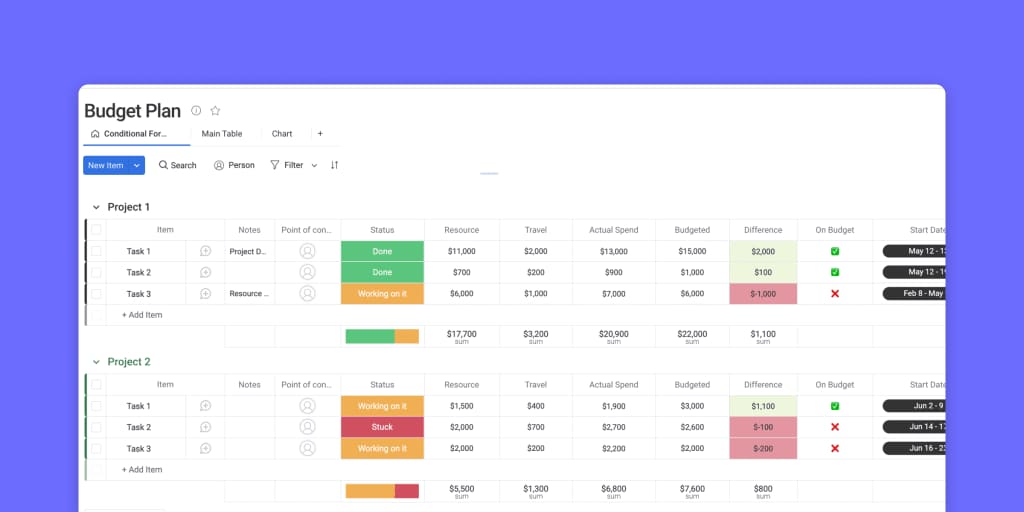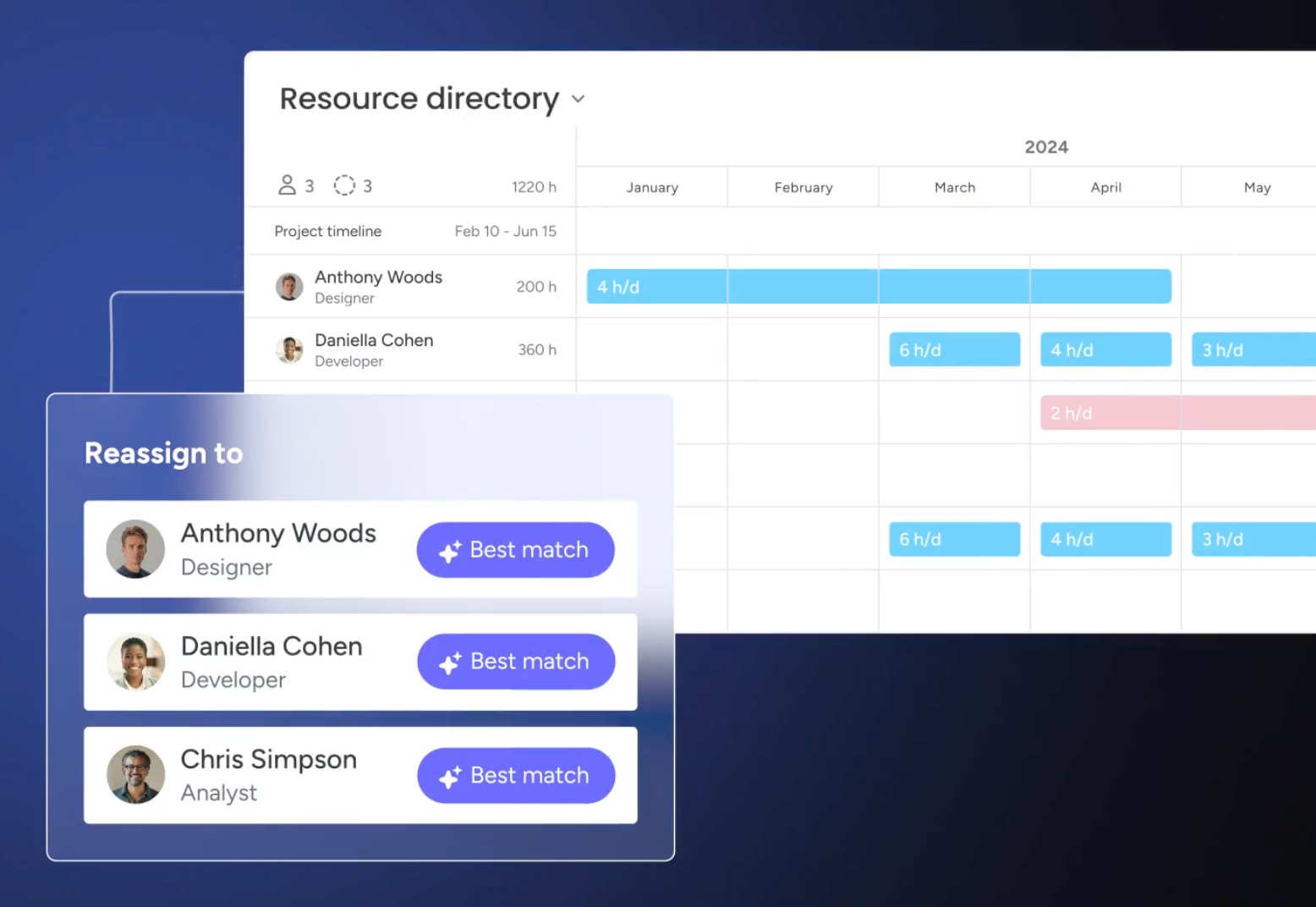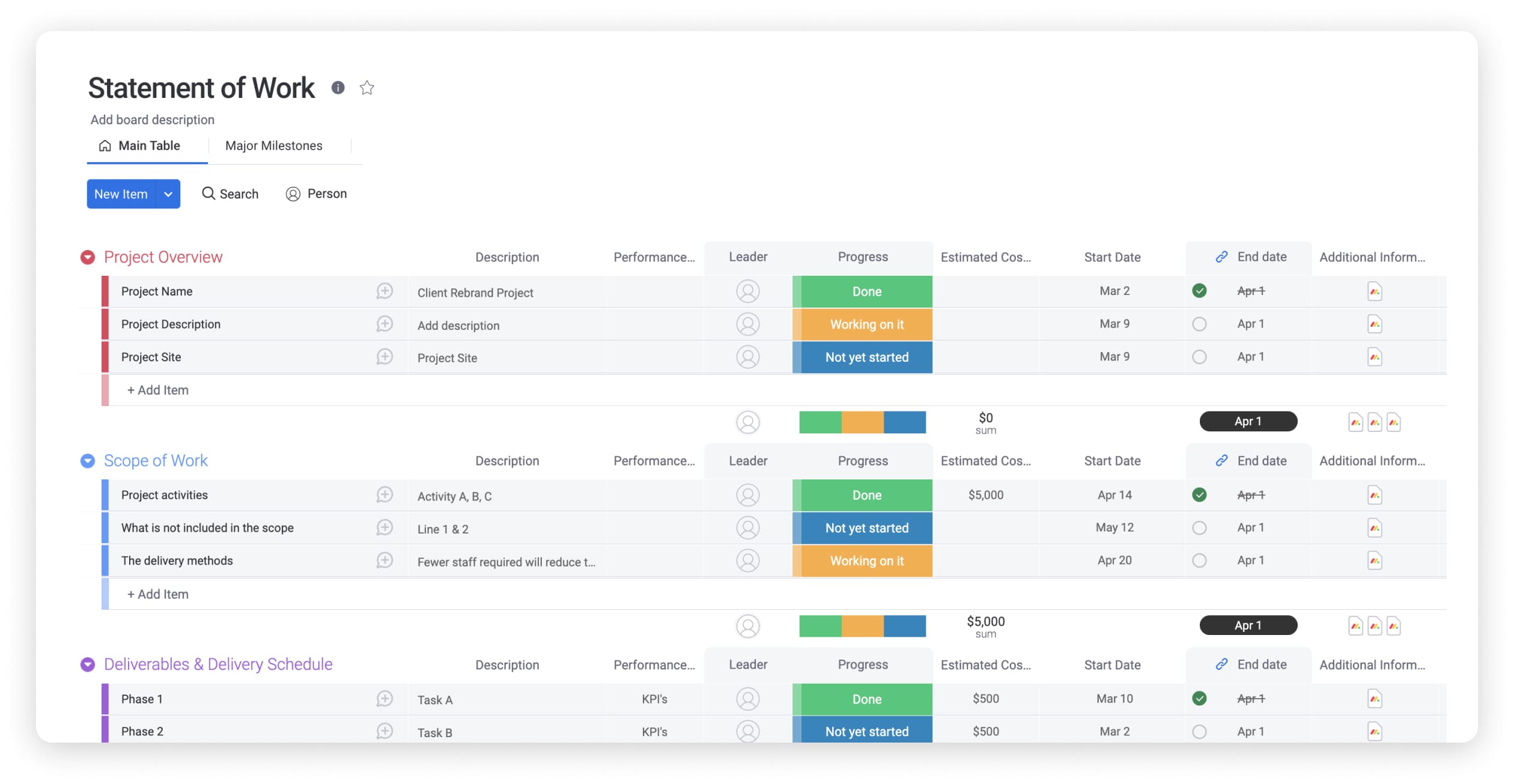Every project is an investment in a future outcome. But without a clear financial roadmap, that investment is at risk from the start. A well-defined project budget transforms a great idea into a viable plan, ensuring resources are available and aligned with your goals.
This guide walks through the essential steps for creating and managing a project budget. We will cover how to define your project’s scope, estimate costs accurately, and account for risks with a contingency fund. You will also learn how to navigate common challenges like scope creep and keep stakeholders aligned.
Building a budget is more than a financial exercise. It is a strategic process that brings clarity and confidence to your team. By turning abstract goals into concrete numbers, you create a baseline for making smart decisions, tracking progress, and ultimately delivering successful projects on time and within financial limits.
Try monday work managementKey takeaways
- Financial roadmap: A project budget allocates money for all project costs from start to finish, helping you make smart spending decisions and anticipate changes that could impact objectives.
- Creating an effective budget requires seven systematic steps: defining scope, identifying resources, estimating costs, factoring in contingencies, consolidating the budget, getting stakeholder approval, and monitoring ongoing expenses.
- monday work management transforms static budgets into dynamic planning tools with real-time dashboards, automated tracking, and collaborative features that connect financial planning with project execution.
- Common budget challenges like scope creep, inaccurate estimates, and communication gaps can be overcome through structured change control, historical data analysis, and transparent stakeholder engagement.
- Successful budget management requires continuous monitoring with regular check-ins, proactive resource adjustments, and real-time tracking platforms that provide early warnings and enable quick corrections when variances occur.
What is a project budget?
A project budget is the total amount of money allocated to complete a specific project. This includes all costs from start to finish — salaries, materials, equipment, and services needed to deliver your project goals.
Think of it as your financial roadmap. It shows exactly where money will go and helps you make smart spending decisions throughout your project. Unlike regular business expenses that keep running, project budgets have clear start and end dates — tied to specific deliverables.

Why does budgeting a project matter?
A clear budget provides financial visibility from the start. It empowers you to answer key questions, like whether you can afford the project scope or how to respond when priorities shift mid-project.
Strong budgeting prevents financial surprises that derail objectives. When you plan and monitor costs properly, you can secure the right funding upfront and protect your project’s scope. This predictability builds stakeholder confidence and creates room for strategic thinking.
Resource optimization becomes possible with clear budgets. You can prioritize projects based on return on investment and ensure resources flow to initiatives that matter most. monday work management helps visualize these allocation decisions in real-time, turning static budgets into dynamic planning instruments on a unified platform.
How can leadership make smart choices without knowing true project costs? Proper budgeting enables data-driven decisions about portfolios, resources, and priorities while demonstrating professional management capabilities.
7 steps to create a project budget plan
Building a project budget requires systematic thinking. These steps help you translate project ideas into financial reality.
Step 1: Define project scope and deliverables
Start by documenting exactly what your project will produce. List every deliverable — reports, software features, events, or marketing materials. Be specific about what’s included and what’s not.
Clear boundaries prevent scope creep from inflating costs later. When everyone understands project limits, your estimates stay accurate and expectations remain aligned.
Step 2: Identify resource requirements
Transform scope into concrete needs. What resources will deliver each output? Consider these four categories:
- Human resources: Team members, contractors, and experts
- Equipment and technology: Hardware, software licenses, specialized tools
- Materials and supplies: Physical items consumed during the project
- External services: Consultants, vendors, third-party providers
Map each deliverable to its required resources. This reveals dependencies and opportunities for sharing across project phases.

Step 3: Estimate costs for each activity
Turn resource needs into dollar amounts. Choose estimation techniques based on your situation:
- Bottom-up estimating: Calculate the costs of individual activities and sum them up to get a project total.
- Analogous estimating: Use similar past projects as your baseline
- Parametric estimating: Apply cost-per-unit rates to quantities
- Three-point estimating: Consider best, worst, and most likely scenarios
Document assumptions behind each estimate. This supports adjustments when conditions change.
Step 4: Factor in contingencies and risks
Projects rarely go exactly as planned. Add contingency funds — typically 5-15% of total cost — based on complexity and risk tolerance.
Identify specific risks that could increase costs. Technical challenges, resource availability, and external factors all deserve consideration. Develop strategies to reduce both likelihood and impact of these risks.
Step 5: Consolidate and review your budget
Combine all estimates into one comprehensive document. Check for overlaps or double-counted expenses. Validate assumptions with experts and stakeholders.
Format your budget for different audiences. Executives need summaries while project managers require detailed breakdowns. monday work management lets you create multiple views from the same data, ensuring everyone gets relevant information.
Step 6: Get stakeholder buy-in
Present your budget clearly using visuals that highlight key decisions. Address questions by explaining major cost categories and their connection to deliverables.
Document formal approval to establish your baseline. Communicate how budget changes will be handled to prevent future misunderstandings.
Step 7: Monitor ongoing costs against the plan
Track actual spending as it happens. Compare real costs to planned amounts regularly. Investigate variances to understand causes and identify trends.
Take corrective action when needed — adjust scope, reallocate resources, or modify timelines. Real-time dashboards in monday work management automate this tracking, updating as teams log time and expenses.
Key cost categories for project management budget
Different cost types behave differently and need specific management approaches. Understanding these categories improves both planning and control.
Direct costs trace straight to your project:
- Project team salaries
- Contractor fees
- Project-specific materials
- Travel expenses
Indirect costs support the project but aren’t exclusive to it:
- Office space and utilities
- Administrative support
- General equipment
- Insurance and legal coverage
Fixed costs stay constant regardless of project size. Plan these early since they require upfront commitment. Variable costs fluctuate with activity levels, offering flexibility but needing closer monitoring.
Contingency fund
Contingency isn’t extra money — it’s planned buffer for uncertainty. Size depends on several factors:
- Project complexity: More dependencies mean larger buffers
- Historical data: Past overruns guide future planning
- Risk assessment: Higher risks require more reserves
- Organizational standards: Company guidelines set minimums
Fixed vs variable expenses
Cost behavior affects both planning and control. Fixed costs like software licenses are predictable but inflexible. Variable costs like hourly labor adapt to needs but require constant oversight.
Plan fixed costs early through negotiation and contracts. Monitor variable costs through usage tracking and regular reviews. Each type needs different management strategies.
Try monday work managementCommon challenges and how to overcome them
Even solid budgets face obstacles. Understanding these challenges helps maintain control and deliver success.
Scope creep and unplanned changes
Scope creep gradually expands requirements beyond original plans. Combat this through structured change control:
- Evaluate all modifications: Review proposals before implementation
- Calculate full impact: Show cost and schedule effects clearly
- Communicate consequences: Ensure stakeholders understand trade-offs
- Document everything: Track approved changes and budget effects
monday work management’s change tracking features maintain visibility into modifications and their financial impact through customizable approval workflows, automated notifications, and financial impact calculators.
The platform logs all change requests with timestamps and ownership, allowing teams to trace budget adjustments back to specific scope changes. Real-time dashboards highlight variance between original and current budgets, while integration with project timelines shows how financial decisions affect delivery schedules — all accessible to stakeholders through permission-based sharing.

Inaccurate cost estimations
Estimation improves with practice and better data. Build accuracy through:
- Historical databases: Track actual costs from past projects
- Expert involvement: Leverage experienced team members
- Multiple techniques: Compare different estimation methods
- Progressive refinement: Update estimates as details emerge
Communication gaps
Poor communication can create budget surprises and delays. This risk is amplified by perception gaps; for example, while 45% of senior leaders believe change is managed ‘very well,’ only 23% of individual contributors agree. Prevent issues through:
- Regular updates: Use consistent formats and timing
- Clear documentation: Make assumptions accessible to all
- Stakeholder involvement: Keep decision-makers engaged
- Transparent tracking: Share dashboards and reports openly
Delayed approvals
Approval delays increase costs through extended timelines and idle resources. Speed decisions by:
- Early engagement: Involve approvers during planning
- Clear presentation: Provide complete supporting documentation
- Built-in buffer: Include approval time in schedules
- Escalation paths: Define backup procedures for delays
Project budget examples for real world insights
These examples show how budgeting principles apply across different scenarios. Each highlights unique decisions and lessons:
Software implementation requires budgeting for licenses, training, and services. Key decisions include cloud versus on-premise solutions, user adoption investment, and ongoing support planning.
Marketing campaigns need creative development, media spend, and measurement budgets. Balance creative ambitions with available funds while maintaining flexibility for optimization.
Office relocations involve moving costs, equipment, and productivity impacts. Prioritize essential upgrades, minimize downtime, and coordinate multiple vendors effectively.
Different project types require tailored approaches. Match your strategy to specific risks, constraints, and success factors while maintaining financial discipline.

How to stick with your budget in changing environments
Projects evolve constantly. Adaptive management keeps budgets on track despite changing conditions. Here’s what we recommend:
Use real time tracking platforms
Current data enables proactive decisions, and with 82% of employees already using work management software, teams are primed to leverage platforms that offer this real-time visibility. Real-time tracking provides:
- Early warnings: Spot issues before they escalate
- Informed choices: Base decisions on current reality
- Stakeholder confidence: Demonstrate professional management
- Quick corrections: Act fast when variances occur
Host regular check-ins
Make reviews proactive, not reactive. Schedule dedicated budget meetings for:
- Performance analysis: Review actual versus planned spending
- Variance investigation: Understand root causes of differences
- Trend identification: Spot patterns indicating future issues
- Action planning: Develop specific responses to concerns
Adjust resources proactively
Maintain control through flexible resource management:
- Flexible staffing: Use contractors for variable workloads
- Scope prioritization: Focus on critical elements first
- Timeline optimization: Adjust schedules for efficiency
- Alternative approaches: Find creative solutions to constraints
Smart adjustments preserve budget integrity while adapting to reality.
Get started with smarter budgeting
Project budgeting improves with practice and proper tools. Systematic approaches create accurate budgets while continuous improvement refines future estimates.
Technology transforms budget management from manual struggle to streamlined process. Team collaboration improves both accuracy and commitment when the right people participate.
monday work management connects financial planning with project execution through a unified platform. Its budget and project cost tracking capabilities automatically calculate spend against allocations, while real-time dashboards visualize budget health with color-coded status indicators.
Collaborative features like @mentions, approval workflows, and permission-based sharing ensure the right stakeholders contribute to financial decisions.
The platform’s customizable formulas calculate ROI and variance automatically, while integration with timelines and workloads helps teams understand how budget adjustments impact delivery — all helping teams create, maintain, and optimize budgets effectively throughout project lifecycles.
Try monday work managementFAQs about project budgets
What is the difference between a project budget and a project plan?
The difference between a project budget and a project plan is that a budget focuses specifically on financial aspects — how much the project costs and where money goes. A project plan is much broader, encompassing everything including timelines, resources, tasks, and deliverables, with the budget as just one component. A project plan encompasses everything including timelines, resources, tasks, and deliverables, with the budget as one component.
How do you calculate contingency for a project budget?
Contingency typically ranges from 5-15% of total project cost. Determine your percentage by assessing project risks, reviewing similar past projects, and following organizational guidelines for buffer planning.
Can AI help automate project budgeting tasks?
AI automates cost estimation, expense categorization, and variance analysis. Modern platforms predict overruns, suggest optimizations, and generate automated reports that save time while improving accuracy.
What should you do if your project budget gets cut mid-project?
Immediately reassess scope and priorities with stakeholders. Focus resources on critical deliverables and explore alternatives like phased delivery or reduced features to achieve core objectives within new constraints.
How often should you review and update a project budget?
Review budgets monthly at minimum, with more frequent checks for complex projects. Update whenever scope changes, resources shift, or actual costs deviate significantly from plans.
Is contingency funding always necessary for project budgets?
Contingency funding is essential for all projects since unexpected costs are common. Even well-planned projects face unforeseen circumstances, making contingency critical for responsible management rather than optional padding.
 Get started
Get started 

